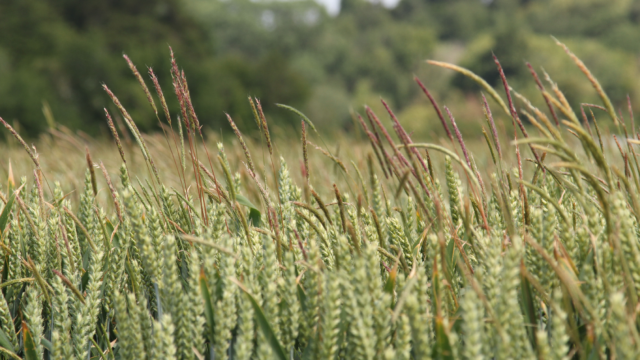Written by Richard Halleron from Agriland
 Blackgrass is a particularly persistent weed of winter wheat. Its success is largely due to widespread, multiple-herbicide resistance.
Blackgrass is a particularly persistent weed of winter wheat. Its success is largely due to widespread, multiple-herbicide resistance.
A new study has shown that whether or not blackgrass will be herbicide-resistant depends on more than just what is on its chromosomes.
Blackgrass is a growing threat on Irish tillage farms. It is believed that resistant strains of the weed have been coming into the country on imported machinery.
Once established, heavy infestations of herbicide-resistant grassweed can reduce cereal yields by up to 1.5t/ac.
The use of integrated pest management (IPM) practices will help to reduce the impact of blackgrass.
But getting a stronger research insight into the weed’s genetic mode of action is key to the development of future management and eradication strategies.
Rothamsted Research, in collaboration with scientists at Clemson University (US), has found that blackgrass has small loops of DNA that are outside the plant’s chromosomes.
These loops, called extra-chromosomal circular DNA (eccDNA), are not inherited in the same way that the chromosomes are.
They evolve separately from the main genetic structures in the cell nucleus and could help explain how blackgrass can rapidly develop resistance to herbicides or other stresses.
The research team identified the similarities and differences in the eccDNA in both resistant and sensitive populations.
Although the numbers and size of detected eccDNAs varied between the populations, comparisons managed to identify shared and unique genes and protein coding.
Compared to blackgrass that are herbicide sensitive, the eccDNA of herbicide-resistant weed have extra copies of genes known to confer herbicide resistance, including genes related to herbicide detoxification.
Previous analysis of resistant and non-resistant varieties had clearly shown that resistance develops across multiple genes, but until now the mechanisms of how blackgrass could rapidly evolve these differences have been hard to pin down.
The researchers have shown that a combination of differences in chromosomal and eccDNA encoded genes might be responsible for the rapid evolution of herbicide resistance in blackgrass.
Rothamsted’s Dr. Dana MacGregor commented: “Because of advances in sequencing, we are now finding eccDNAs in many different species and are starting to understand what they do.
“Having these eccDNAs may contribute to the genetic diversity we see in blackgrass and explain how it has so successfully adapted to man-made and abiotic stresses, including herbicide treatment.”
Also Read: Tillage: Making a nutrient management plan
The post DNA loops provide clue to herbicide resistance in blackgrass appeared first on Agriland.co.uk.
Continue reading on the Agriland Website...

A new study has shown that whether or not blackgrass will be herbicide-resistant depends on more than just what is on its chromosomes.
Blackgrass is a growing threat on Irish tillage farms. It is believed that resistant strains of the weed have been coming into the country on imported machinery.
Once established, heavy infestations of herbicide-resistant grassweed can reduce cereal yields by up to 1.5t/ac.
Tackling blackgrass
The use of integrated pest management (IPM) practices will help to reduce the impact of blackgrass.
But getting a stronger research insight into the weed’s genetic mode of action is key to the development of future management and eradication strategies.
Rothamsted Research, in collaboration with scientists at Clemson University (US), has found that blackgrass has small loops of DNA that are outside the plant’s chromosomes.
These loops, called extra-chromosomal circular DNA (eccDNA), are not inherited in the same way that the chromosomes are.
They evolve separately from the main genetic structures in the cell nucleus and could help explain how blackgrass can rapidly develop resistance to herbicides or other stresses.
The research team identified the similarities and differences in the eccDNA in both resistant and sensitive populations.
Although the numbers and size of detected eccDNAs varied between the populations, comparisons managed to identify shared and unique genes and protein coding.
Compared to blackgrass that are herbicide sensitive, the eccDNA of herbicide-resistant weed have extra copies of genes known to confer herbicide resistance, including genes related to herbicide detoxification.
New information
Previous analysis of resistant and non-resistant varieties had clearly shown that resistance develops across multiple genes, but until now the mechanisms of how blackgrass could rapidly evolve these differences have been hard to pin down.
The researchers have shown that a combination of differences in chromosomal and eccDNA encoded genes might be responsible for the rapid evolution of herbicide resistance in blackgrass.
Rothamsted’s Dr. Dana MacGregor commented: “Because of advances in sequencing, we are now finding eccDNAs in many different species and are starting to understand what they do.
“Our findings show that blackgrass has eccDNAs, and on them are copies of chromosomal genes we know to be correlated with herbicide resistance.
“Having these eccDNAs may contribute to the genetic diversity we see in blackgrass and explain how it has so successfully adapted to man-made and abiotic stresses, including herbicide treatment.”
Also Read: Tillage: Making a nutrient management plan
The post DNA loops provide clue to herbicide resistance in blackgrass appeared first on Agriland.co.uk.
Continue reading on the Agriland Website...





